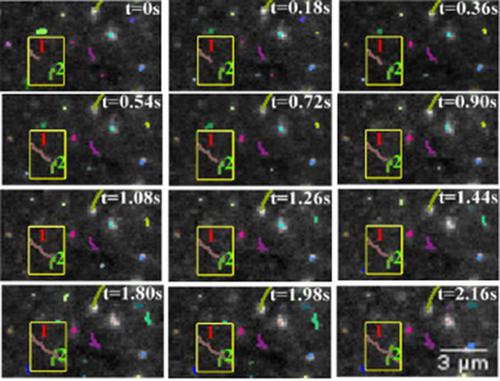当前位置:
X-MOL 学术
›
Microsc. Res. Tech.
›
论文详情
Our official English website, www.x-mol.net, welcomes your
feedback! (Note: you will need to create a separate account there.)
Development of fan-shaped tracker for single particle tracking.
Microscopy Research and Technique ( IF 2.0 ) Pub Date : 2020-04-23 , DOI: 10.1002/jemt.23496 Luhong Jin 1 , Fengqiang Zhao 1 , Wanni Lin 1 , Xiaoxu Zhou 1 , Cuifang Kuang 2 , Alexander Nedzved 3 , Sergey Ablameyko 3 , Xu Liu 2 , Yingke Xu 1, 4
Microscopy Research and Technique ( IF 2.0 ) Pub Date : 2020-04-23 , DOI: 10.1002/jemt.23496 Luhong Jin 1 , Fengqiang Zhao 1 , Wanni Lin 1 , Xiaoxu Zhou 1 , Cuifang Kuang 2 , Alexander Nedzved 3 , Sergey Ablameyko 3 , Xu Liu 2 , Yingke Xu 1, 4
Affiliation

|
With the development of super‐resolution fluorescence microscopy, complex dynamic processes in living cells can be observed and recorded with unprecedented temporal and spatial resolution. Single particle tracking (SPT) is the most important step to explore the relationship between the spatio‐temporal dynamics of subcellular molecules and their functions. Although previous studies have developed SPT algorithms to quantitatively analyze particle dynamics in cell, traditional tracking methods have poor performance when dealing with intersecting trajectories. This can be attributed to two main reasons: (a) they do not have point compensation process for overlapping objects; (b) they use inefficient motion prediction models. In this paper, we present a novel fan‐shaped tracker (FsT) algorithm to reconstruct the trajectories of subcellular vesicles in living cells. We proposed a customized point compensation method for overlapping objects based on the fan‐shaped motion trend of the particles. Furthermore, we validated the performance of the FsT in both simulated time‐lapse movies with variable imaging quality and in real vesicle moving images. Meanwhile, we compared the performance of FsT with other five state‐of‐the‐art tracking algorithms by using commonly defined measures. The results showed that our FsT achieves better performance in high signal‐to‐noise ratio conditions and in tracking of overlapping objects. We anticipate that our FsT method will have vast applications in tracking of moving objects in cell.
中文翻译:

开发用于单粒子跟踪的扇形跟踪器。
随着超分辨率荧光显微镜技术的发展,可以观察和记录活细胞中复杂的动态过程,并以前所未有的时间和空间分辨率进行记录。单粒子跟踪(SPT)是探索亚细胞分子时空动力学与其功能之间关系的最重要步骤。尽管先前的研究已经开发出SPT算法来定量分析细胞中的粒子动力学,但是传统的跟踪方法在处理相交轨迹时性能较差。这可以归因于两个主要原因:(a)它们没有针对重叠对象的点补偿过程;(b)他们使用低效的运动预测模型。在本文中,我们提出了一种新颖的扇形跟踪器(FsT)算法,以重建活细胞中亚细胞囊泡的轨迹。我们根据粒子的扇形运动趋势提出了一种针对重叠对象的定制点补偿方法。此外,我们在具有可变成像质量的模拟延时电影和实际囊泡运动图像中都验证了FsT的性能。同时,我们通过使用共同定义的度量,将FsT与其他五种最新跟踪算法的性能进行了比较。结果表明,我们的FsT在高信噪比条件下以及对重叠物体的跟踪中均具有更好的性能。我们预计,我们的FsT方法将在跟踪单元格中的移动物体方面具有广泛的应用。我们根据粒子的扇形运动趋势提出了一种针对重叠对象的定制点补偿方法。此外,我们在具有可变成像质量的模拟延时电影和实际囊泡运动图像中都验证了FsT的性能。同时,我们通过使用共同定义的度量,将FsT与其他五种最新跟踪算法的性能进行了比较。结果表明,我们的FsT在高信噪比条件下以及对重叠物体的跟踪中均具有更好的性能。我们预计,我们的FsT方法将在跟踪单元格中的移动物体方面具有广泛的应用。我们根据粒子的扇形运动趋势提出了一种针对重叠对象的定制点补偿方法。此外,我们在具有可变成像质量的模拟延时电影和实际囊泡运动图像中都验证了FsT的性能。同时,我们通过使用共同定义的度量,将FsT与其他五种最新跟踪算法的性能进行了比较。结果表明,我们的FsT在高信噪比条件下以及对重叠物体的跟踪中均具有更好的性能。我们预计,我们的FsT方法将在跟踪单元格中的移动物体方面具有广泛的应用。我们在具有可变成像质量的模拟延时电影和实际囊泡运动图像中都验证了FsT的性能。同时,我们通过使用共同定义的度量,将FsT与其他五种最新跟踪算法的性能进行了比较。结果表明,我们的FsT在高信噪比条件下以及对重叠物体的跟踪中均具有更好的性能。我们预计,我们的FsT方法将在跟踪单元格中的移动物体方面具有广泛的应用。我们在具有可变成像质量的模拟延时电影和实际囊泡运动图像中都验证了FsT的性能。同时,我们通过使用共同定义的度量,将FsT与其他五种最新跟踪算法的性能进行了比较。结果表明,我们的FsT在高信噪比条件下以及在跟踪重叠物体时都具有更好的性能。我们预计,我们的FsT方法将在跟踪单元格中的移动物体方面具有广泛的应用。
更新日期:2020-04-23
中文翻译:

开发用于单粒子跟踪的扇形跟踪器。
随着超分辨率荧光显微镜技术的发展,可以观察和记录活细胞中复杂的动态过程,并以前所未有的时间和空间分辨率进行记录。单粒子跟踪(SPT)是探索亚细胞分子时空动力学与其功能之间关系的最重要步骤。尽管先前的研究已经开发出SPT算法来定量分析细胞中的粒子动力学,但是传统的跟踪方法在处理相交轨迹时性能较差。这可以归因于两个主要原因:(a)它们没有针对重叠对象的点补偿过程;(b)他们使用低效的运动预测模型。在本文中,我们提出了一种新颖的扇形跟踪器(FsT)算法,以重建活细胞中亚细胞囊泡的轨迹。我们根据粒子的扇形运动趋势提出了一种针对重叠对象的定制点补偿方法。此外,我们在具有可变成像质量的模拟延时电影和实际囊泡运动图像中都验证了FsT的性能。同时,我们通过使用共同定义的度量,将FsT与其他五种最新跟踪算法的性能进行了比较。结果表明,我们的FsT在高信噪比条件下以及对重叠物体的跟踪中均具有更好的性能。我们预计,我们的FsT方法将在跟踪单元格中的移动物体方面具有广泛的应用。我们根据粒子的扇形运动趋势提出了一种针对重叠对象的定制点补偿方法。此外,我们在具有可变成像质量的模拟延时电影和实际囊泡运动图像中都验证了FsT的性能。同时,我们通过使用共同定义的度量,将FsT与其他五种最新跟踪算法的性能进行了比较。结果表明,我们的FsT在高信噪比条件下以及对重叠物体的跟踪中均具有更好的性能。我们预计,我们的FsT方法将在跟踪单元格中的移动物体方面具有广泛的应用。我们根据粒子的扇形运动趋势提出了一种针对重叠对象的定制点补偿方法。此外,我们在具有可变成像质量的模拟延时电影和实际囊泡运动图像中都验证了FsT的性能。同时,我们通过使用共同定义的度量,将FsT与其他五种最新跟踪算法的性能进行了比较。结果表明,我们的FsT在高信噪比条件下以及对重叠物体的跟踪中均具有更好的性能。我们预计,我们的FsT方法将在跟踪单元格中的移动物体方面具有广泛的应用。我们在具有可变成像质量的模拟延时电影和实际囊泡运动图像中都验证了FsT的性能。同时,我们通过使用共同定义的度量,将FsT与其他五种最新跟踪算法的性能进行了比较。结果表明,我们的FsT在高信噪比条件下以及对重叠物体的跟踪中均具有更好的性能。我们预计,我们的FsT方法将在跟踪单元格中的移动物体方面具有广泛的应用。我们在具有可变成像质量的模拟延时电影和实际囊泡运动图像中都验证了FsT的性能。同时,我们通过使用共同定义的度量,将FsT与其他五种最新跟踪算法的性能进行了比较。结果表明,我们的FsT在高信噪比条件下以及在跟踪重叠物体时都具有更好的性能。我们预计,我们的FsT方法将在跟踪单元格中的移动物体方面具有广泛的应用。









































 京公网安备 11010802027423号
京公网安备 11010802027423号